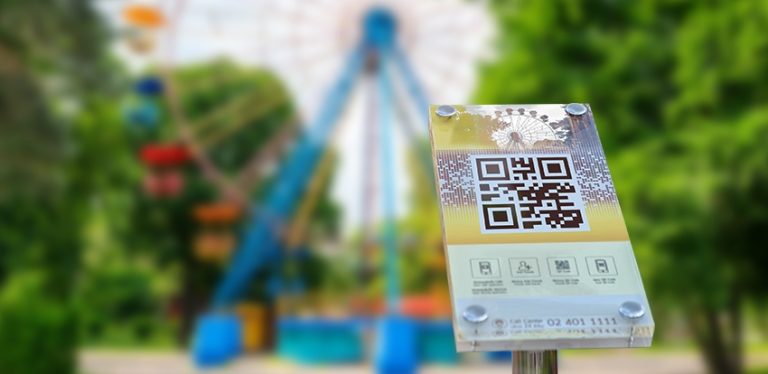Last Updated on February 28, 2024 by
As the outside world is slowly reopening its doors to millions of people who are missing the thrill of adventure and work, the means of interaction they usually know changes from interpersonal to contactless interactions.
And with these changes made, restaurants, retail shops, hospitals, and hotels are incorporating the use of QR codes to house their digital contact tracing and check-in forms, food, and amenities list, and more. Throughout their new normal operations, the following establishments have set a brighter means of operations for other industries to follow.
Recreational parks stand as vibrant sanctuaries in the heart of urban landscapes, offering a breath of fresh air and a break from the hustle and bustle of daily life. These green havens are meticulously designed to cater to diverse interests, providing spaces for sports, picnics, relaxation, and cultural events. Whether adorned with jogging trails, playgrounds, or serene ponds, recreational parks serve as gathering spots where communities converge to unwind and foster connections. The laughter of children on playgrounds mingles with the quiet contemplation of those seeking solace in nature. These parks play a pivotal role in promoting physical well-being, mental health, and a sense of unity among residents. As integral components of city planning, recreational parks contribute to the overall quality of life, enriching the tapestry of our shared public spaces.
With amusement and recreational parks as one of the highly affected industries that are having doubts about reopening its doors to the public, the food and hospitality, and health industries that brave their new normal operations become their strategic example on how they can maximize their contactless park operations with QR codes.
Table of Contents
Why go contactless with QR codes?
Since not all smartphone users have the Near Field Communication (NFC) chipset installed right through their phones, the use of QR codes becomes the business and other industries’ go-to contactless tool to integrate with their new normal operations.
Aside from the compatibility capability QR codes give to most smartphone users today, here are other reasons why businesses and other sectors go contactless with QR codes.
Easy to use
As the main goal for businesses is to create an effective means to adapt to the changing operation set up today, the use of QR codes provides the business owners a better outlet to run an easier means to run a contactless operation. Through its scan and view manner, complications in running a contactless business are eradicated.
Cost lesser
With different QR code software competing online, the cost of creating a QR code becomes lesser than other contactless tools. Because of that, many business owners have the option to choose a QR code generator that supplies their every QR code needs at reasonable pricing.
Thanks to the QR code market competition currently happening today, business owners can save more money and resources through thorough comparison and trial usage.
Can embed any type of data
As having one tool for all the required contactless inputs means great for an establishment to focus and create, QR codes can attach any type of data into its coding system. Whether you need to embed digital forms, PDF, images, audio, text, video, and URL, these square grid codes can encode and decode them without breaking their original file format.
How do amusement and recreational parks utilize the use of QR codes in its contactless park operations?
Since most businesses are using QR codes to operate successful contactless operations, the amusement and recreational parks are maximizing the use of it in three notable ways.
Digital Park Maps
Amusement park owners are using QR codes to store digital park maps for guests to easily scan and save the map. To do this, amusement park operators use an image QR code to store the image file of the park map and place them in prominent areas where guests can easily see and scan them to get the easiest route to their next amusement rides.
Through the use of the Park Map QR code, guests can make the most of their time in the park without leaving one ride or attraction not being experienced by them.
Ticket inquiry
Since amusement parks are finally reopening their doors to select park goers, their operation means selling tickets to their customers changes. As lining up to ticket booths is now discouraged by the health regulation committee, amusement park owners are incorporating the use of QR codes to issue tickets for their customers that state the specific time and date for their tour in the park. Through their use of it, they can ensure that the customers get their tickets from their online ticketing booth and take count on how many customers have officially inquired and bought legitimate tickets from them.
Portal for Virtual Tours
As going contactless means limiting the number of people going into the park itself, some amusement park goers who still wish to experience the magic are finding other means to get into the park virtually.
Because of that, amusement park operators are considering providing virtual tours for their park patrons who cannot physically go to their parks. And for them to make a successful virtual tour experience operations, they integrate the use of a QR code generator with logo to create online personalized virtual tour QR code tickets for their customers.
Conclusion:
As limiting engagements between park staff and guests in the amusement and other theme parks is one of the challenges park owners have to endure during these times, the need for contactless engagements intensifies.
Because of that, amusement and recreational park operators are taking a new step of redefining their park experience in a contactless way with QR codes.
Apart from this, if you are interested to know more about QR Codes in the Classroom to Improve Learning then visit our Technology category.



